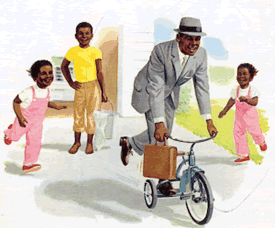African American Dick and Jane
Listen to the Recess! Clip
| Author | John Cech |
| Air Date | 2/18/2000 |

Dick and Jane Transcript
The Dick and Jane readers that most baby boomers and pre-boomers learned their alphabets from first appeared in 1930. The idea was the brainchild of Zerna Sharp, a reading consultant, who thought that children could best learn how to read and write from characters with whom they could identify and from simple language that was close to home. Sharp proposed the idea to William Gray of the Scott Foresman company, which was then publishing a series of basil texts, the Elson Readers, and he turned the project over to her and a production team that ultimately gave us these idealized American children who were visually imprinted on their audience through the large color illustrations of Eleanor Campbell. To give the children even more authenticity, their clothing was based on the styles that could be found in the Sears and Montgomery Ward catalogues.
Two decades later, over three-quarters of America’s first graders were reading the Dick and Jane books, with their “whole word,” controlled vocabularies. There were even versions of the reader with religious themes and images for use in parochial schools. But it wasn’t until 1965, a year after the Civil Rights Act, that people of any color other than pink appeared in the series — in the form of an African American family with a mother and father, the twin girls, Pam and Penny, and an older brother, Mike (There always has to be an older brother to help fashion cardboard boxes into play houses or to weave colored streamers into the spokes of your tricycle.) Mike was the same age, size and temperament as Dick — in fact, as the historians of the Dick and Jane books have pointed out, he’s Dick’s first real friend. Pam’s and Penny’s and Mike’s family have the same values, the same work ethic, the same material things. Their dad is a white collar worker too; and their mom is a housewife. Perhaps the only major difference lies in the fact that their grandparents live in the city in an apartment, not in the country, like Dick’s and Jane’s. The text designers clearly were careful in their demographic research. And Pam’s and Penny’s and Mike’s family brings something wonderful to the street — a sense of style, of energy, laughter and joy. Despite what was going on in the world outside, in these sheltered pages, there was complete harmony and perhaps, too, a hope.